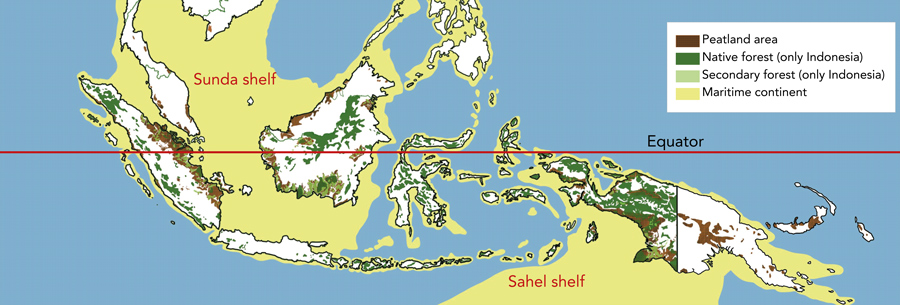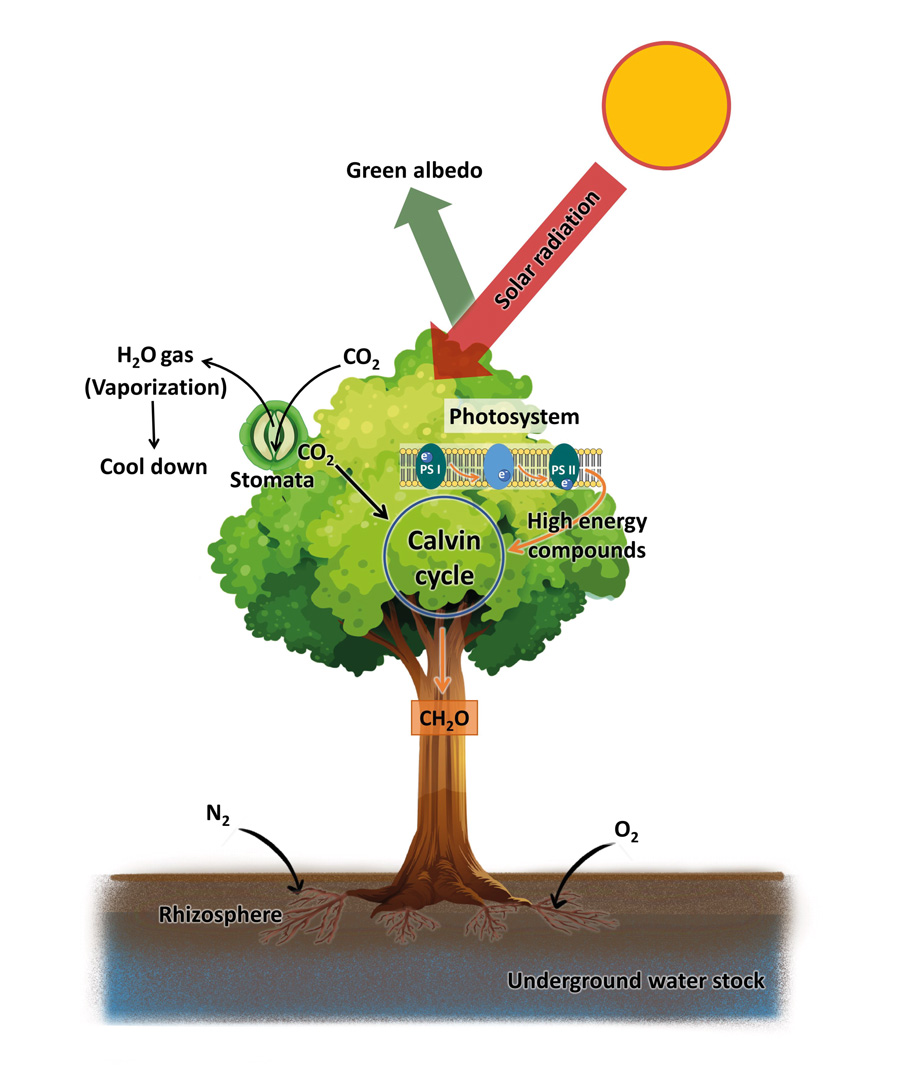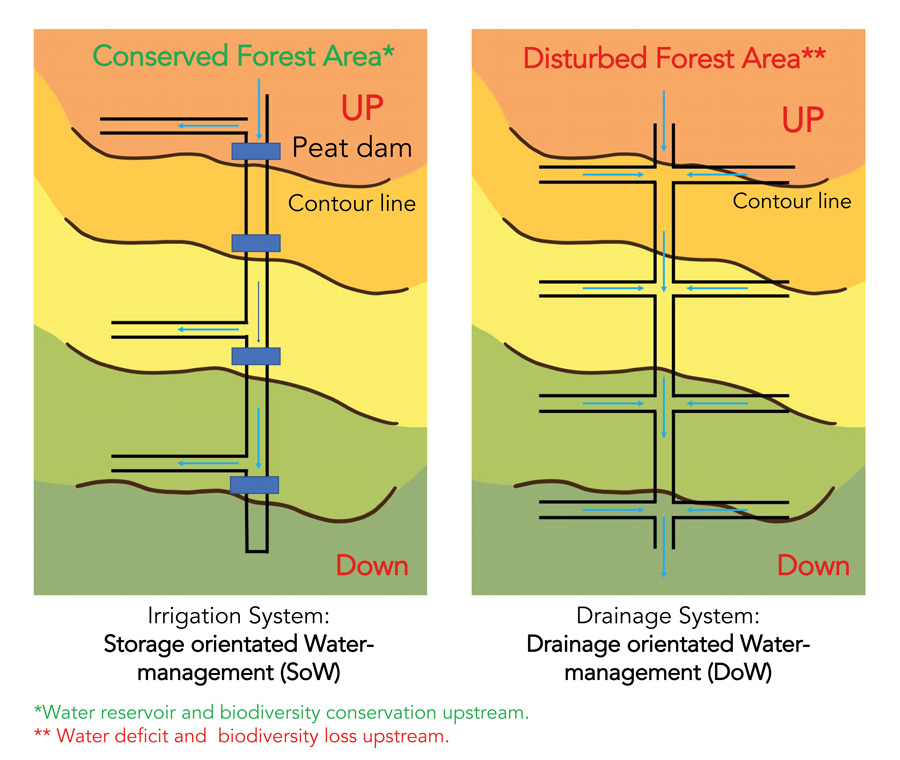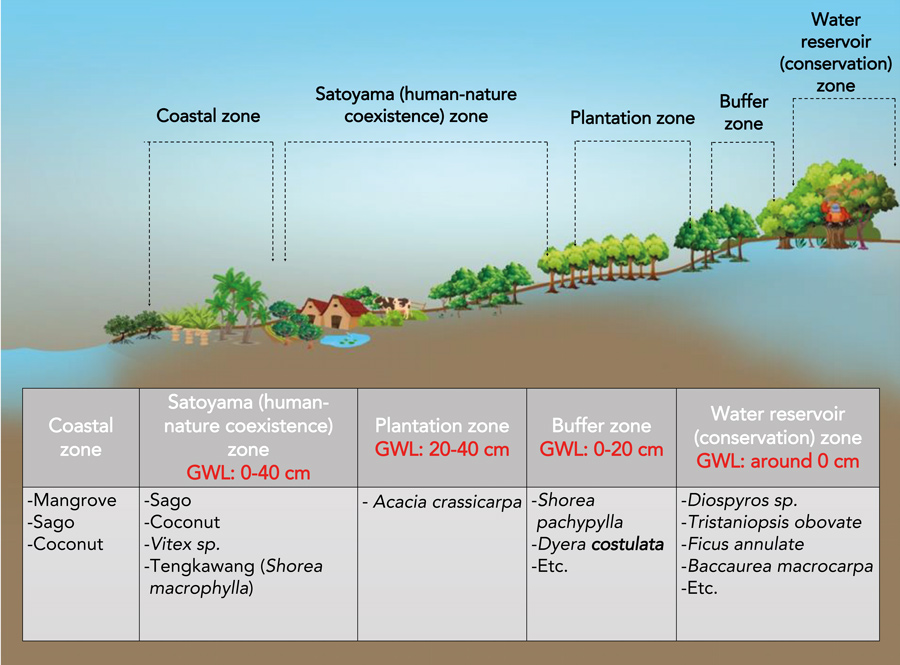Triharmony/Trilemma of Water Assets in tropical peatland
Commercial crops are generally susceptible to high soil moisture and groundwater levels. As such, conventional water management schemes called ‘Drainage orientated Water-management’ (DoW), predominate in areas of tropical peatland, especially plantations, and are characterised by low groundwater levels. Reducing the groundwater level for agriculture and plantations has long been a fundamental aim for tropical peatland management. Consequently, the DoW has significant impacts on the degradation of tropical peatland (1).
It is known that the Indian Ocean Dipole (or IOD, the irregular changes in sea-surface temperatures) causes prolonged drought in Indonesia’s tropical peatlands around Maritime Continents so that groundwater levels (GWL) drop and peat is prone to fire (Figure 1). However, a recently published study (2) which measured GWL over 27 years, highlights a Trilemma state caused by an imbalance in Water Asset, as a consequence of both natural processes and human activities. A new water management system, known as Triharmony, is therefore urgently needed to address this issue (3).
Triharmony based on large-scale water management in tropical peatlands
In tropical peatland, the three key elements water, carbon, and nutrients are interrelated, interconnected, and interact (Figure 2). When these elements are in balance, a Triharmony state arises. Conversely, a Trilemma state occurs when these elements are out of balance. Therefore, focusing on water, Professor Tsuyoshi Kato at Sumitomo Forestry Co, Ltd and colleagues have developed an innovative system, ‘Storage orientated Water-management’ (SoW) that applies eco-management principles to peatland water resources. In large-scale tropical peatland ecosystems, four components are considered: (1) water management and land-use planning, (2) biodiversity conservation planning, (3) new technologies to preserve peat, and (4) their evaluation systems. The goals of eco-management in large-scale tropical peatlands include: (1) establish a carbon-negative system, including mitigation and adaptation strategies to combat global climate change; (2) address biodiversity conservation at the landscape level; and (3) provide socioeconomic security to local communities.

To meet these goals, eco-management approaches are designed to preserve and maintain the functions of the original ecosystem. Firstly, a clear inventory of the interconnected water resources and processes within the ecosystem is needed, and involves three main tasks: 1) inventory of water stocks and reservoirs, 2) inventory of irrigation usage, and 3) inventory of water cycling processes that support 1) and 2). In terms of the water cycle, key processes are evapotranspiration – the movement of water from the land to the atmosphere via evaporation from the land or transpiration from leaves; and precipitation – the opposing process whereby water is transferred from the atmosphere to the land via rain, ice, and snow.
Triharmony approaches are designed to maintain original ecosystem functions.Although there is an extensive body of literature on agricultural water management, most studies have focused on ‘Drainage orientated Water-management’ (DoW) systems. Conversely, peatland water management has received relatively little attention; the few studies done are superficial, with no in-depth analysis of management approaches or optimal practices. In addition, in real-world settings economic and operational efficiencies are commonly prioritised over sustainable water management. At the same time, recent serious IOD events in the Maritime Continent areas close to peatland, reveal major flaws in the DoW system that impact on peatland development. The DoW system is partially complemented by canal blocking, however it is not effective in dry seasons, and especially not during IOD events. There is therefore a vital need to fully reconsider these water management systems (Figure 3).
‘drainage orientated Water-management’ (DoW)
In tropical peatland, conventional DoW is designed to drain water from the ecosystem as quickly as possible. A central canal is constructed down the slope of the peat dome (an area where the peat layer is thicker than that of surrounding areas, forming topographical relief), with secondary canals branching off along contour lines. Water then drains into the secondary canals, which in turn drain into the primary canal. It then flows rapidly down the slope, through the canal channel and into a river. Establishing such a system is straightforward, requiring only rudimentary knowledge of the land (ie, the primary direction of the steepest slope). In the short term, this approach offers false economic value. However, draining the water from peat, a naturally high-water environment, results in the eventual degradation of peat soils, resulting in a serious Trilemma state.

Farmers, and in particular large-scale oil palm plantation producers that dominate the majority of peatland agriculture in tropical regions, are reluctant to expend additional investment to update their irrigation systems, particularly when they are unsure of the impact on productivity. However, with growing recognition of long-term peat degradation, industrial producers have increasingly aimed to update canal infrastructure, moving away from a DoW to a SoW approach. The simplest way to do this is by constructing peat dams, not canal blocking across the main canal at each contour level, allowing water to be retained in the system for longer time periods.
Ultimately, such updates to infrastructure are costly and require a much more comprehensive survey of the land and water resources. Moreover, with IOD and other changes in climate reducing the water supply, regardless of the irrigation system, more refined and sustainable approaches must be adopted to maintain the balance between water inputs, outputs, and storage. However, implementation of any such system is easier said than done, with the need to account for a variety of interconnected moving parts (ie, macro- and micro-topography, peat thickness, groundwater, and variations in climate variables such as precipitation and temperature).
The innovative SoW approach developed by Kato and collaborators refers to the blueprint of traditional paddy-field irrigation and is designed to achieve a high level of water retention within the ecosystem. The approach has four main principles: 1) achieve a stable groundwater level across the year, 2) prevent peat fires, 3) encourage tree growth, and 4) conserve the native ecosystem as best as possible (Figure 3).
‘Storage orientated Water-management’ (SoW)
The research team has tested this SoW approach in Indonesia by applying it to degraded peatland areas damaged by commercial agriculture, slash-and-burn, and illegal logging. They found that a groundwater level of 0.4m below the surface was appropriate for the healthy growth of acacia trees. In terms of plot design, the optimal layout is a 10–12m wide/3m-deep main canal running down one side of the plot, from high- to low elevation. Branch canals of 6–8m wide/3m deep should extend at right angles from the main canal, running along the lines of contour. Peat dams should be used to block the main canal, with the interval between them determined by a 0.5–0.6m drop in elevation. Spillways, designed based on the maximum expected rainfall, provide a protection mechanism in the case of extreme precipitation by releasing excess water from the site.

This canal network design not only allows for tightly controlled groundwater levels and long-term retention of water to support the ecosystem, but also provides a firebreak and water supply in the event of a fire. This, in turn, helps to support biodiversity corridors. Fires, which are common in peatlands using DoW, destroy habitats and result in massive losses to biodiversity. Ultimately, however, successful protection of both water resources and biodiversity requires coordinated management over a large scale; that is, it requires multiple stakeholders (including local communities, smallholders, industrial farms, and local governments) to work together in a coordinated approach (Figures 3 and 4).
Triharmony models require short-term financial outlays to protect long-term growth.Achieving innovative water management in tropical peatlands
Kato and collaborators have tested their approach in peatland areas of West Kalimantan, Indonesia. Over a ten-year period, two companies with large industrial plantation concessions tested various methods for water management. They evaluated the advantages and disadvantages in terms of productivity, economic efficiency, and environmental sustainability.
Based on their findings, the researchers suggest that Triharmony peatland management adheres to four principles to ensure sustainable peatland management: 1) preservation of intact forests (ie, no clearing of forests for development); 2) a harmonious balance between economic, environmental, and social factors; 3) business models that emphasise sustainability; and 4) the use of low cost, simple technologies that are easy to maintain (3).

The SoW system can help to support each of these principles. The simplest and quickest way to create such a system is the construction of peat dams across existing drainage canals, to form a protected environmental buffer zone around the upper reservoir layer that supports water storage and biodiversity. Additional measures to support these changes could include the installation of simple monitoring equipment to collect real-time data on current conditions (ie, rainfall and temperature), allowing dynamic management of water flow on the site. Maximising the effectiveness of this approach also requires detailed fine-scale topographical surveys. With the advent of drone technology, this is easier and cheaper than ever before.
Truly large-scale and sustainable improvements to water management in tropical peatlands will rely on the widespread adoption of more NbS (Nature-based Solution) business models by large-scale agricultural stakeholders. The acceptance of these innovated Triharmony models may require short-term financial outlays to protect long-term growth (Figure 4).
Personal Response
Your work is focused on tropical peatlands. Are any of the concepts transferable to other climate systems?As Water–Carbon–Nutrients are the three key elements for any climate system (or ecosystem), Triharmony is also the basic system in mangrove and wetland, as well as desert, semi-arid-, and arable land. However, we must choose the appropriate Triharmony technology for each particular climate system, or ecosystem.